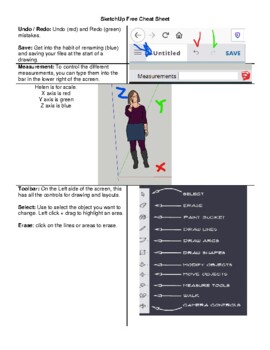SketchUp Free Cheat Sheet
3D-PT
125 Followers
Grade Levels
9th - 12th, Higher Education, Adult Education, Homeschool, Staff
Resource Type
Standards
CCSSHSG-CO.A.1
CCSSHSG-CO.A.2
CCSSHSG-CO.A.3
CCSSHSG-CO.A.4
CCSSHSG-CO.A.5
Formats Included
- PDF
- Easel Activity
Pages
7 pages
3D-PT
125 Followers
Easel Activity Included
This resource includes a ready-to-use interactive activity students can complete on any device. Easel by TPT is free to use! Learn more.
Description
SketchUp Free is the basic cloud based version of SketchUp that you can use to start 3D drawing. With this version you can export 3D printable .stl files as well as .skp, .jpg, .png graphic files.
While it does not have the full range of the paid versions of SketchUp, you can use this to explore and start 3D modeling. Advanced features or teacher accounts will require a site license.
This cheat sheet goes through the basic tools and commands that you will use to start 3D modeling.
Total Pages
7 pages
Answer Key
N/A
Teaching Duration
2 hours
Last updated Nov 12th, 2020
Report this resource to TPT
Reported resources will be reviewed by our team. Report this resource to let us know if this resource violates TPT’s content guidelines.
Standards
to see state-specific standards (only available in the US).
CCSSHSG-CO.A.1
Know precise definitions of angle, circle, perpendicular line, parallel line, and line segment, based on the undefined notions of point, line, distance along a line, and distance around a circular arc.
CCSSHSG-CO.A.2
Represent transformations in the plane using, e.g., transparencies and geometry software; describe transformations as functions that take points in the plane as inputs and give other points as outputs. Compare transformations that preserve distance and angle to those that do not (e.g., translation versus horizontal stretch).
CCSSHSG-CO.A.3
Given a rectangle, parallelogram, trapezoid, or regular polygon, describe the rotations and reflections that carry it onto itself.
CCSSHSG-CO.A.4
Develop definitions of rotations, reflections, and translations in terms of angles, circles, perpendicular lines, parallel lines, and line segments.
CCSSHSG-CO.A.5
Given a geometric figure and a rotation, reflection, or translation, draw the transformed figure using, e.g., graph paper, tracing paper, or geometry software. Specify a sequence of transformations that will carry a given figure onto another.






